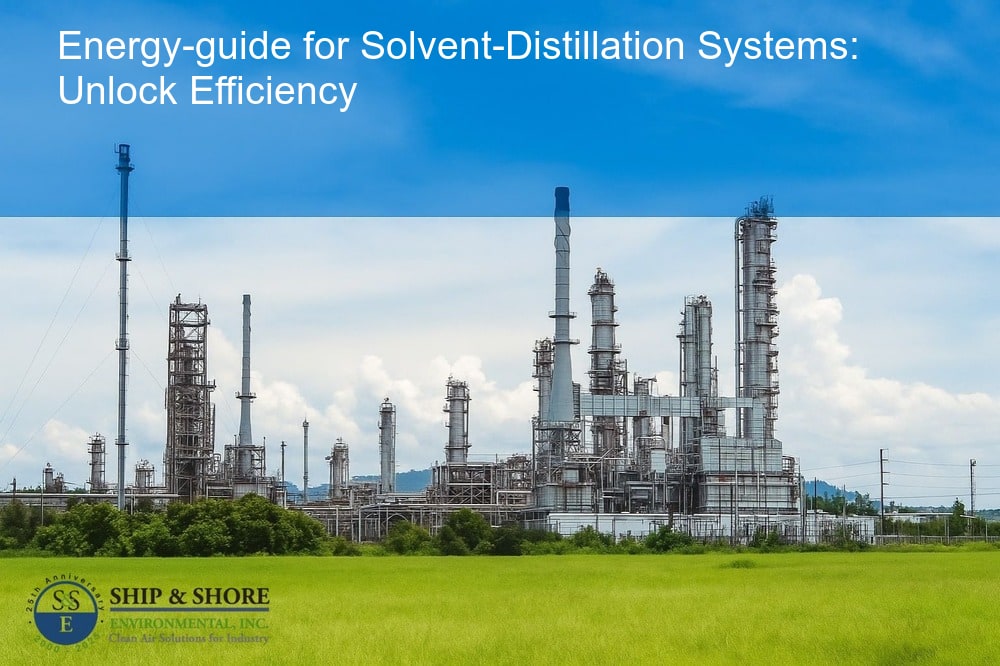
Energy-Guide for Solvent-Distillation Systems: Maximizing Efficiency
November 26, 2025 6:04 amThe Urgency for Energy Efficiency in Solvent-Distillation Processes
In today’s rapidly evolving industrial landscape, the quest for energy efficiency has never been more urgent. As industries worldwide push towards sustainability and cost-effectiveness, the importance of optimizing solvent-distillation processes has come into sharp focus. At Ship & Shore Environmental, Inc., we believe that an Energy-guide for solvent-distillation systems is central to this endeavor. These systems, essential for separating and purifying chemicals, are fundamental in a myriad of industrial applications, from pharmaceuticals to petrochemicals. However, their energy-intensive nature makes them prime candidates for efficiency improvements.
Understanding Solvent Distillation: An Overview
Solvent distillation is a critical process that involves the separation of mixed liquid compounds through heating and evaporation. The principle behind it is straightforward – different compounds have different boiling points, and this variance allows for their separation when heat is applied. But achieving this separation with minimal energy expenditure is the challenge. Traditional methods can be incredibly wasteful, often consuming large amounts of energy, which translates to higher operational costs and environmental impact. Consequently, refining these processes to be more energy-efficient is crucial.
Energy-Guide for Solvent-Distillation Systems: Why it Matters
Implementing an Energy-guide for solvent-distillation systems can revolutionize how industries operate by vastly reducing energy consumption and lowering costs. Moreover, enhancing the efficiency of these distillation processes aligns with broader sustainability goals, such as reducing greenhouse gas emissions and conserving natural resources. By adopting advanced technologies and refining existing methodologies, industries can achieve significant advancements in performance and energy conservation. This guide serves as the keystone for fostering such improvements, offering a roadmap to more efficient and eco-friendly industrial operations.
Exploring Energy-Saving Strategies in Solvent-Distillation
In a world where energy resources are becoming increasingly strained, enhancing the efficiency of our solvent-distillation systems is crucial. Incorporating energy-saving strategies is not only a matter of reducing costs but also a practical approach to minimizing environmental impact.
One effective method is optimizing the operating conditions of distillation columns. Careful adjustment of pressure, temperature, and reflux ratios can lead to significant energy savings. Additionally, utilizing advanced process controls ensures that the system operates under optimal conditions at all times.
Another strategy involves integrating heat recovery systems. By capturing and reusing waste heat within the distillation process, we can considerably reduce the energy required for solvent separation. For instance, energy recuperation can be achieved through heat exchangers, which transfer heat from the hot vapor to the cooler feed stream, thus preheating it and saving energy.
Role of High-Efficiency Technologies in Solvent-Distillation Systems
Implementing high-efficiency technologies is essential in our journey toward energy conservation. One such technology is the use of advanced distillation column internals. Structured packings, high-performance trays, and efficient reboilers are designed to enhance the effectiveness of each stage in the distillation process. These technologies ensure better mass transfer, leading to reduced energy consumption.
Another noteworthy advancement is the adoption of vacuum distillation. By lowering the operating pressure in the distillation column, we can significantly reduce the boiling points of the solvents. This results in lower energy requirements for heating and vaporizing the solvents, making the process more energy-efficient. Vacuum systems not only save energy but also improve product quality by minimizing thermal decomposition.
Furthermore, the implementation of real-time monitoring and control systems cannot be overstated. These systems provide continuous data on energy usage and process performance, enabling prompt adjustments to maintain optimal operation. By leveraging data analytics and machine learning, we can predict and rectify inefficiencies before they escalate, ensuring consistent energy savings.
Real-World Success Stories: Energy Conservation in Industrial Distillation
The practical application of energy-saving measures and high-efficiency technologies has yielded remarkable results in the industry. Several companies have seen substantial energy reductions and cost savings by adhering to the Energy-guide for solvent-distillation systems.
- An international chemical manufacturer integrated heat recovery systems and saw a 15% reduction in energy consumption.
- A major pharmaceutical company adopted advanced distillation column internals, achieving a 20% increase in separation efficiency while lowering energy costs.
- A mid-sized industrial solvents producer implemented vacuum distillation and reduced their energy usage by 25%, leading to substantial annual savings.
These success stories underline the potential for significant improvements when adopting energy-efficient practices. By continuously exploring new technologies and strategies, we can further enhance our solvent-distillation systems’ performance and sustainability. The challenges are considerable, but the benefits of improved energy efficiency – both economically and environmentally – make the endeavor worthwhile.
Did you know that implementing high-efficiency technologies in solvent-distillation systems can significantly cut energy costs and contribute to sustainability goals?
Building the Future: The Role of Energy Efficiency in Sustainability Goals
As we delve into the pursuit of sustainable development, the urgency for optimizing energy efficiency in solvent-distillation processes becomes evident. Our collective aim should be to forge a future where energy conservation is not an option, but an integral part of operational strategies. Embracing the Energy-Guide for Solvent-Distillation Systems will significantly contribute to our sustainability objectives by reducing carbon footprints and enhancing overall environmental health. This commitment to energy efficiency aligns seamlessly with the broader goals of sustainability, ensuring that our industrial activities support a balanced ecosystem.
The Financial Advantage of Implementing Energy-Guide for Solvent-Distillation Systems
Harnessing the potential of the Energy-Guide for Solvent-Distillation Systems isn’t merely an environmental necessity; it also presents substantial financial benefits. By implementing energy-saving strategies and high-efficiency technologies, operations will see a marked reduction in energy consumption and associated costs. Our recent case studies demonstrate how numerous industries have reported significant savings post-implementation, validating the economic rationale behind this energy-centric approach. The financial gains amplify the incentive to adopt energy-efficient practices, fostering a culture where cost savings and ecological responsibility go hand in hand.
Final Thoughts: The Path Ahead for Energy Efficiency in Solvent-Distillation
In conclusion, the adoption of the Energy-Guide for Solvent-Distillation Systems is more than just a technological upgrade – it represents a paradigm shift in our approach to industrial processes. By prioritizing energy efficiency, we not only advance towards our environmental and financial goals but also set a precedent for future innovations. The integration of energy-saving measures and high-efficiency technologies should be seen as an ongoing commitment, not a one-time solution. As we move forward, continuous monitoring, evaluation, and adaptation will be crucial to sustain and build upon the gains achieved.
The road ahead is promising, filled with opportunities to innovate and refine our practices. As we champion energy efficiency in solvent-distillation, we’re not just unlocking new levels of operational efficiency; we’re securing a sustainable and economically viable future for industries worldwide. Let’s leverage the Energy-Guide for Solvent-Distillation Systems to transform the landscape of industrial distillation, and in doing so, become the stewards of a greener, more sustainable world.
FAQ
Why is energy efficiency important for solvent-distillation processes?
Enhancing energy efficiency is crucial in solvent-distillation processes as it bolsters our sustainability efforts by curbing emissions, reduces operating costs, and supports the long-term viability of industrial operations. Consequently, by pursuing energy-efficient distillation methods, we contribute to environmental conservation and adhere to increasingly stringent regulations.
What are some energy-saving strategies for solvent distillation?
Implementing advanced heat integration techniques, optimizing operating conditions, and utilizing high-performance equipment are pivotal strategies for saving energy. Moreover, conducting regular system maintenance and monitoring can also uncover additional opportunities for energy conservation, ensuring that solvent distillation operates at peak efficiency.
Can you provide examples of high-efficiency technologies in distillation systems?
Indeed, technologies such as vapor recompression, advanced heat exchanger networks, and energy-efficient distillation columns play an instrumental role. These technologies streamline energy use, exemplifying how modern advancements can augment performance while simultaneously fostering responsible energy consumption in industrial activities.
How do energy-efficient practices in distillation impact the bottom line?
Adopting energy-efficient practices in distillation can significantly lower energy expenditures, translating into cost savings for the company. Additionally, these practices often result in improved process control and product quality, which in turn can lead to increased market competitiveness and profitability.
What steps should be taken to ensure the continuous improvement of energy efficiency in solvent distillation?
Continual improvement can be achieved by staying abreast of the latest technological advancements, fostering a culture of innovation, and investing in employee training. Additionally, regular performance evaluations and adaptations to processes will help maintain and even further energy efficiency gains, cultivating an ethos of sustained progress in industrial solvent distillation.
Categorised in: Blog

